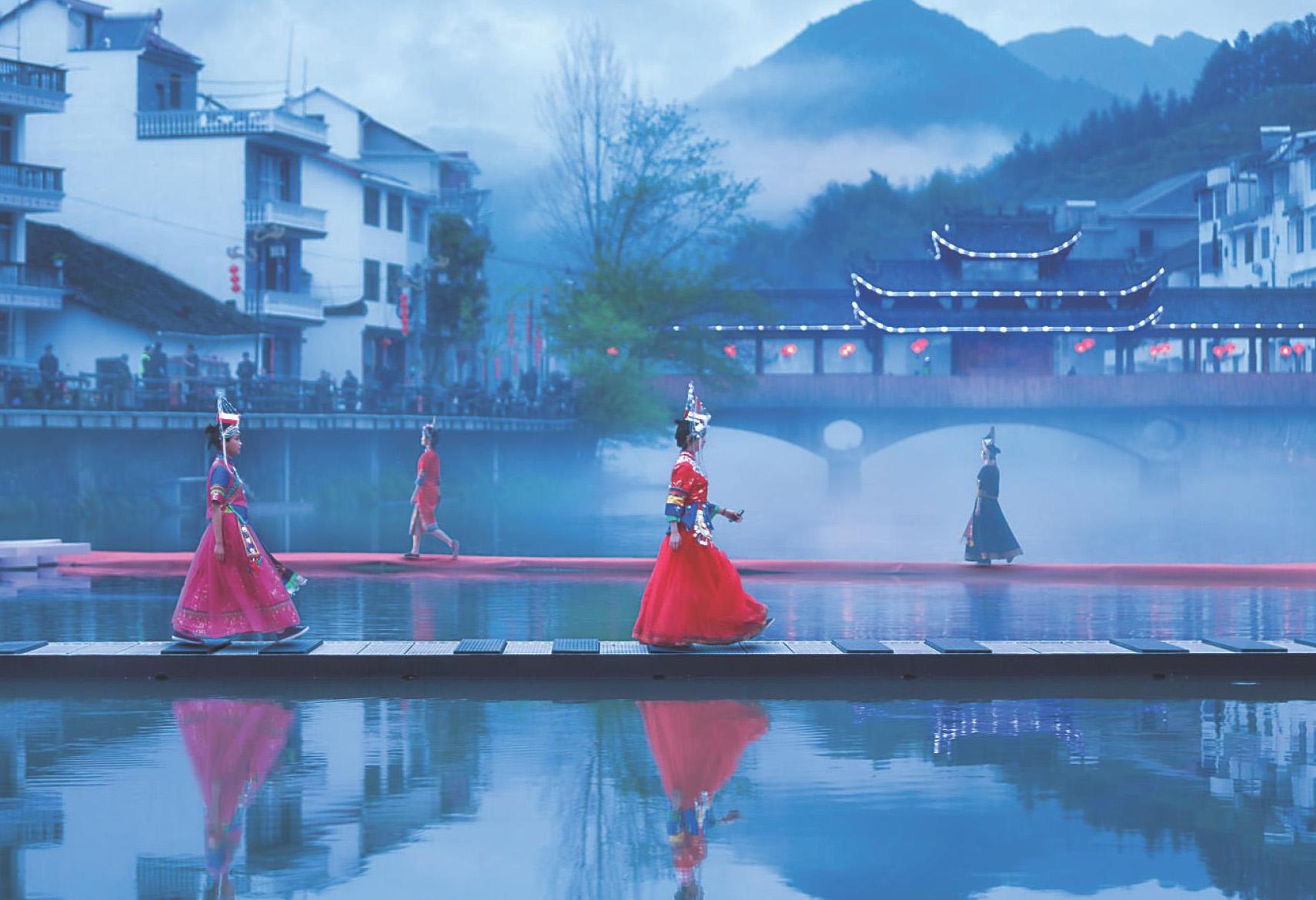百舸争流 千帆竞发
2021-05-31



百舸争流,奋楫者先;千帆竞发,勇进者胜。
四条诗路文化带建设是诗画浙江大花园的标志性工程,这是一件很有意义的事,也是一项很有内涵的工作,具有从古至今走向未来的重大意义,也是文化浙江建设的一张“金名片”。
自2018年以来,浙江四条诗路文化带建设一路高歌猛进,诗路文化建设规划布局思路日渐明晰,诗路沿线各地也是积极有为,“干了一些大事,做了一些实事”。
让诗路“看得见摸得着”
2020年4月,被称为“中华第一高瀑布”的天台山大瀑布建成运营,这是天台县把大瀑布景区定位为天台山风景旅游的核心景区,作为“名县美城”的标志性项目之一,列入省重点建设项目和省重大产业示范项目。
这是天台近几年来坚持文旅兴县的卓越成果,该县在打响“浙东唐诗之路目的地”品牌上,牢牢把握“物化、活化、产业化”三个关键点,深入挖掘当地的唐诗文化资源,让这些唐诗能够看得见、摸得着,感受得到。大瀑布的恢复拓展了“浙东唐诗之路”经济带,也为天台文旅增添了一个高吸引力的新IP。
同期,位于新昌天姥山风景名胜区的鼓山公园建成开放,项目规划用地约628亩,主要设置入口广场区、文化休闲区、生态山林区、天姥揽胜区、滨江休闲区、运动健身区等功能分区。
新昌鼓山公园,展现在世人面前的是一个有机融合唐诗文化、乡土文化,集大型绿色空间、开阔公共活动场地、文化旅游景点于一体的综合性城市公园,是唐诗之路上一个地标式的主题公园,并为新昌市民和广大游客再添一处可登、可憩、可游、可观景的休闲旅游场所。
围绕诗路文化带建设,上虞、嵊州等地也纷纷完成“诗画剡溪”曹娥江综合整治。诗画剡溪项目位于曹娥江畔,南起屠家埠,北至下市头,全长18.7公里,总面积131.84公顷。项目依托剡溪山水人文资源,憑借绿色基底的整体打造,唐诗之路文化的整合串联,“清风诗韵”、“漫花滩地”等节点的精品散布,预设“绿道+水道”的双系统游览线路,做到“水利、旅游、景观、生态、文化”的五位一体的功能融合。
在丽水,缙云仙都成功创成5A级旅游景区。这是浙江第18个,丽水第一个国家级5A景区,从而为瓯江山水诗路文化带建设再添一金名片。
在金华,兰溪至建德水上诗路复航,成为打造钱塘江诗路“明珠”,兰溪位于钱塘江中游,是钱塘江诗路文化带建设的一个重要节点。为了让三江六岸成为钱塘江诗路文化带上的靓丽景观,形成独特的“大美兰溪”特色,兰溪深入挖掘文化宝藏,把人文与自然、文脉与山水、遗产与景区、浙学文脉与现代成果等有机组合,打造水上游线路,在山水人文中绘就现代版“富春山居图”。
绘就蓝图换“新颜”
沿线各地也在积极绘就蓝图拟换“新颜”。
“东南山水越为首,天下风光数会稽”,绍兴市柯桥区正积极谋划建设稽山鉴水唐诗路,该区平水镇文化璀璨,历史文化源远流长,山水风光优美,曾吸引了唐代众多诗人的吟唱,大约有450多位诗人游历了这条山水走廊,并在此留下了众多诗文。
为了重现这条诗路的辉煌,将沿线上具有丰厚传统文化积淀的乡村振兴起来,打造全新的文旅体验,柯桥区谋划在诗路上重现“稽山鉴水唐诗路”,为浙东唐诗之路添砖加瓦。
为重振这条唐诗之路,柯桥发布了“诗路柯桥”手绘线路;稽山鉴水作为浙东唐诗路上精华之精华段,更是提出了打造“浙东唐诗之路的开辟地”口号。
萧山也不居人后,正着力打造浙东唐诗之路起点渔浦。渔浦是萧山区义桥镇独特的自然和人文景点,该镇还高分通过“中华诗词之乡”创建验收组的审核,成为了杭州市第一个“中华诗词之乡”。
义桥镇还结合美丽城镇创建,启动了“义桥印象老街”保护整修项目。在改造提升中,义桥镇对建筑采取“修旧如旧”的原则,给老街的房屋都换上了“新衣”,重现了昔日面貌——质朴、恬静的江南韵味。
在余姚,“唐诗之路”景观小品项目已通过前期论证、图纸评审,这意味着该项目建设正式启动。该项目建设投资约550万元,涉及景观7处,分别是四明山牌坊、白水冲、羊额古道、升仙桥、四窗岩、梨洲溪、冷水孔,散布于四明山浒溪线,作为景致点缀,并提升意义。同时,在“唐诗之路”上,项目将应用“互联网+”,完善智慧旅游载体,依托其旅游交通干道,承接自驾游及过境市场,以进一步挖掘周边文化景区与乡村旅游资源。
与此同时,大运河诗路文化带相关项目也在推进中,2020年大运河国家文化公园杭州项目群开工已达十六个项目,包含了京杭大运河博物院等5个重点文化标杆项目。这5个项目组成的大运河世界文化遗产公园,已被成功列为国家级标志性工程。
2021年,杭州市运河集团将安排132个项目,计划总投资77.6亿元(含土壤治理项目及投资),助推十四五规划开局起步,为大运河诗路文化带建设作出贡献。而地处建德市的梅城和寿昌,为评为2020年度新时代美丽城镇建设省级样板,两镇的千年古城复兴项目正有序推进中。
文旅融合发展
过去的两年里,诗路建设助推文旅产业加快发展。
2019年,浙江省文化产业增加值增长10%,占GDP比重7.4%;旅游总收入破万亿,旅游产业增加值增长9%,占GDP比重7.9%。从文旅产业的增速看,二者均超过了GDP的增速,说明浙江文旅产业的增长空间还很大,未来都将能够成为浙江省的支柱产业。
2020年,浙江省文化和旅游新开工重大项目总计287个,总投资达3078.7亿元。从城市来看,湖州集中开工文旅项目数最多达41个,温州40个,杭州32个,绍兴30个,舟山12个。从投资金额来看,湖州、台州、绍兴、杭州、温州参加集中开工文旅项目投资金额超300亿元,其中湖州投资金额最多达371亿元。
从文旅产业的增速看,二者均超过了GDP的增速,说明浙江省文旅产业的增长空间还很大。为此,在加快挖掘诗路文化的价值之外,诗路文化带建设还将规划打造一批文旅产业发展平台,加快做强做大文旅产业:
在寧海,“十里红妆”文化街区等文化特色街区和小镇建设已经被提上日程,不用多久,一批诗路特色旅游企业将诞生在这里;
围绕唐诗、宋词资源,各地还将系统性地进行挖掘梳理,谋划设计一批唐诗宋词研学游、体验游等旅游路线,供广大游客体验感受;
当然,在诗路文化带建设过程中,各地将重点创新BOT、PPP等模式和投融资机制,以政府投入撬动社会资本积极参与诗路项目建设;
“四条诗路”文化带建设是激发居民消费潜力的需要,也是形成文旅发展新增长点的需要,浙江省文化和旅游厅将以“一部规划、一批项目、一个数字平台、一组艺术作品、一部宣传片、一组节庆活动、一批核心景区、一批最美古村落、一打国际文旅推介、一批重点企业”为重点工作,将四条诗路打造成为中国山水诗魅力人文带、秀山丽水健康养生生态带、高品质生活富民经济带,助力“诗画浙江”建设全国文化高地、中国最佳旅游目的地、全国文旅融合发展样板地。
数字赋能诗路
2020年10月12日,浙江省省长郑栅洁在全省诗路文化带建设动员大会上指出,要加快推进串“珠”成链,加快建设全省“数字诗路”平台,加快布局一批“数字诗路e站”体验中心。瓯江山水诗路上的数字诗路e站永嘉IP开发体验中心于次月投入试运营,这也是浙江省第一个动工建设的数字诗路e站。该项目规划面积1800平方米,由永嘉旅投集团投资1900万元,浙江诗路文化旅游发展公司承建,是一个集数字体验、旅游展示、文化阵地、文产孵化、研学基地于一体的综合平台,是文化资源的数字化及平台建设已成为传承和弘扬传统文化的重要手段。
数字诗路e站是浙江省诗路数字化平台工程的重要内容,利用影像、VR/AR、3D全息投影等数字技术手段,整合开发诗路沿线地区的诗词、景点、历史遗存和非遗传说等IP资源,构建虚实结合的浙江诗路数字化平台。
这也是贯彻落实《浙江省大花园建设行动计划》《浙江省诗路文化带建设规划纲要》、推动诗路沿线地区文化产业高质量发展的创新举措,由浙江省文化产业促进会和浙江省文化产业创新发展研究院牵头,浙江诗路文化旅游发展有限公司负责开发管理,旨在建设成为浙江文化产业数字化样板地,实现诗路IP的深化、转化和物化,成为全省宣传文化系统“三服务”的有力抓手。
这次数字诗路e站开馆,是永嘉聚焦“瓯江山水诗路核心地”打造的落地项目之一。在诗路沿线地区布局建设一批数字诗路e站,这也是建设全省数字诗路平台的重要节点。数字诗路平台建设将逐步实现四条诗路沿线地区跨领域数据的共享与应用,诗路云的“云服务”为文化加码、为旅游赋能,让数据向服务转化,将带动文旅新业态的创新。
数字诗路e站是诗路数字化平台工程的重要内容,永嘉是诗路数字化先行先试的第一个点。数字诗路e站将重点打造数字文化产业研发基地、影视动漫游戏创意人才集聚平台、文旅融合示范基地三大平台。日后,各县(市、区)以永嘉作为借鉴对象,围绕各自地方特色,挖掘文化IP,打造体验中心。
目前,首批数字诗路e站已经签约启动,杭州、宁波、温州、嘉兴、湖州、绍兴、衢州、丽水等诗路沿线地市县与浙江诗路文旅发展公司达成合作意向,共建诗路数字化工程“数字诗路e站”。预计到2022年,全省诗路沿线拟将建成40家以上的数字诗路e站体验中心。
总体看,诗路建设没有现成的模式可循,没有现成的经验可借鉴,四条诗路“一文含四带,十地耀百珠”,串连了全省文化精华之“链”、山水之“链”、全域发展之“链”,各地要根据浙江省诗路文化带发展规划,充分发挥特色优势,有条件、有基础的地方都要抓紧动起来,大力实施“四十百千”工程,形成一批新的景观亮点和旅游景点,人人成园丁、处处成花园,努力把诗路文化带建设成为魅力人文带、黄金旅游带、美丽生态带、富民经济带、合作开放带,为“重要窗口”增光添彩。
(本栏目图片由温州市委宣传部、绍兴市委宣传部、丽水市委宣传部、桐乡市委宣传部、富阳区委宣传部、永嘉县委宣传部和天台县文旅局提供)
Poetry Road Development:
Achievements and Accomplishments
Success only favors those who boldly forge ahead.
As the signature project to build Zhejiang into a “Big Garden”, the development of the Poetry Road Culture Belt is not only an important endeavor to connect Zhejiangs heritage with its future; it has also become a “golden name card” in the building of “Cultural Zhejiang”.
Ever since Zhejiang released the Big Garden Construction Action Plan in 2018, and began to implement the Development Plan to Build the Poetry Road Culture Belt in 2019, myriad accomplishments have been made.
In April 2020, Tiantai Mountain Waterfall, known as “the Highest Waterfall in China”, officially started operation, one of Tiantai countys marquee projects in its campaign to establish itself as a “famous and beautiful county”, and one of the provincial key construction projects and the provincial major industry demonstration projects. In recent years, Tiantai county has consistently followed the concept of “development through cultural tourism”, striving to build itself into an international leisure resort and a retreat for the residents of the Yangtze River Delta. As the “Destination of the Tang Poetry Road in East Zhejiang”, Tiantai has spared no effort in tapping into local cultural resources of Tang poetry, and transforming them into forms that are “concrete, relatable and industrializable”, to which the restoration of the Tiantai Mountain Waterfall bears testament.
During the same period, Gushan Park, located in Tianmu Mountain Scenic Area in Xinchang, opened to public, with a planned land area of about 628 mu (about 42 hectares) and a series of functional sections such as the culture and leisure section, the ecological mountain forest section, Tianmu landscape section, the fitness section. A major theme park along the Tang Poetry Road, Gushan Park is more a city park complex, integrating Tang poetry cultural heritage, rural culture and customs, green and public open space and cultural tourism attractions, and it is a much welcome addition to local residents and tourists.
In Shaoxings Shangyu district and Shengzhou city, the comprehensive improvement of the Caoe River, part of the “Picturesque Shanxi River Project” has been completed. With a total length of 18.7 kilometers and encompassing an area of 131.84 hectares along the Caoe River, the project starts from Tujiabu in the south and ends at Xiashitou in the north, underscored by the rich natural and cultural resources of the Shanxi River, in particular the Tang poetry cultural heritage.
In Lishui city, the Jinyun Xiandu Scenic Area has successfully become a national 5A-level scenic spot, which is the 18th in Zhejiang province and the first in Lishui, and a considerable contribution to the building of the Oujiang River Landscape Poetry Road.
In Jinhua city, the water transportation, i.e. the “water poetry road”, from Lanxi city (in Jinhua) to Jiande city (in Hangzhou), resumed traffic, emerging as the “pearl” of the Qiantang River Poetry Road. Sitting in the middle reaches of the Qiantang river, Lanxi is undoubtedly a crucial point along the Qiantang River Poetry Road, and through integrating cultural “treasures” with charming scenery, the city is painting a modern-day Dwelling in the Fuchun Mountains .
But Zhejiang is not sitting on these achievements. More projects are in store.
“Of landscape in the Southeast, Yue [modern-day Shaoxing] takes the top spot; Of scenery under heaven, none beats the Kuaiji Mountain,” as the saying goes. Shaoxings Keqiao district is thus planning a “Kuaiji Mountain-Jinghu Lake Tang Poetry Corridor”, part of the Tang Poetry Road in East Zhejiang. It is estimated about 450 Tang poets used to travel along the corridor and left behind numerous poems and prose essays. To revitalize the corridor the surrounding rural areas, Keqiao has issued a specially hand-drawn map and Up north, Hangzhous Xiaoshan district has been reviving Yupu, a unique natural and cultural scenic spot in the districts Yiqiao township, as the starting point of the Tang Poetry Road in East Zhejiang. Indeed, Yiqiao has been chosen as the “Home of Chinese Poetry”, the first in Hangzhou. Besides, Yiqiao has also started to refurbish and renovate the towns old street, restoring its old images and the traditional Jiangnan charm.
To the east, a Tang poetry-themed landscaping project worth about 5.5 million yuan was recently approved in Ningbos Yuyao city, which will add a number of decorations and ornaments to seven places. “Internet +” will also be applied in the project, so that residents and tourists will enjoy a smarter experience.
Meanwhile, projects on the Grand Canal Poetry Road have also witnessed steady progress. A total of 16 projects commenced operation in 2020 for the construction of the Grand Canal National Cultural Park. It is reported that, in 2021, the Hangzhou Grand Canal Comprehensive Protection and Development Group will invest a planned total of 7.76 billion yuan for another 132 projects, kickstarting the 14th Five-Year Plan.
In the past two years, the development of the poetry roads has also injected impetus into the cultural tourism industry.
In 2019, the added value of Zhejiangs cultural industry increased by 10%, accounting for 7.4% of the GDP. Total tourism revenue exceeded one trillion yuan, and the added value of the tourism industry increased by 9% and accounted for 7.9% of the GDP. The growth rates of the cultural and tourism industries have exceeded that of the GDP, an indication that there is still huge potential for Zhejiangs cultural and tourism industries to grow.
In 2020, Zhejiang put into operation 287 major cultural and tourism projects, with a total investment of 307.87 billion yuan. Breaking down by cities, Huzhou tops the list with 41 projects, followed by Wenzhou with 40, Hangzhou with 32, Shaoxing with 30 and Zhoushan with 12. Breaking down by the amount of investment, Huzhou again comes first, with 37.1 billion yuan invested. Taizhou, Shaoxing, Hangzhou and Wenzhou have also invested more than 30 billion yuan each.
To tap the potential in the cultural tourism industry, Zhejiang is planning to establish a series of development platforms: developing characteristic cultural blocks and towns, and tourist companies featuring poetry roads; designing educational and cultural tours featuring poetry roads; and optimizing market mechanism to fully leverage social capital.
As Zheng Shanjie, the provincial governor, pointed out, the “four poetry roads” is a central project of Zhejiang, and it will greatly stimulate consumer spending as well as the development of the cultural tourism industry.
In addition, Zhejiang is also developing digital platforms for the poetry roads.
In 2020, Yongjia Center, the e-Poetry Roads first experience center, was officially unveiled. With a total investment of 19 million yuan and covering an area of 1,800 square meters, the Yongjia Center is a comprehensive platform that integrates digital experience, tourism display, cultural incubation, education and research.
It is part of the e-Poetry Road initiative, which aims to integrate and develop such IP resources as poetry, scenic spots, historical relics and intangible cultural heritage through digital technologies such as imaging, VR/AR and 3D holographic projection. As well as the Yongjia Center, the e-Poetry Road initiative will put more centers along the four poetry roads in coming years.
